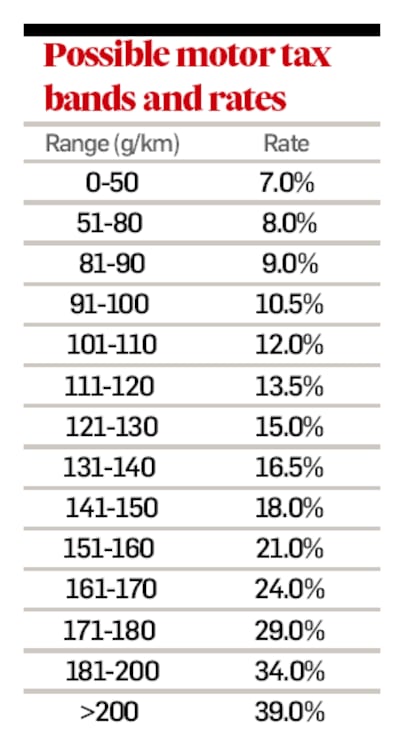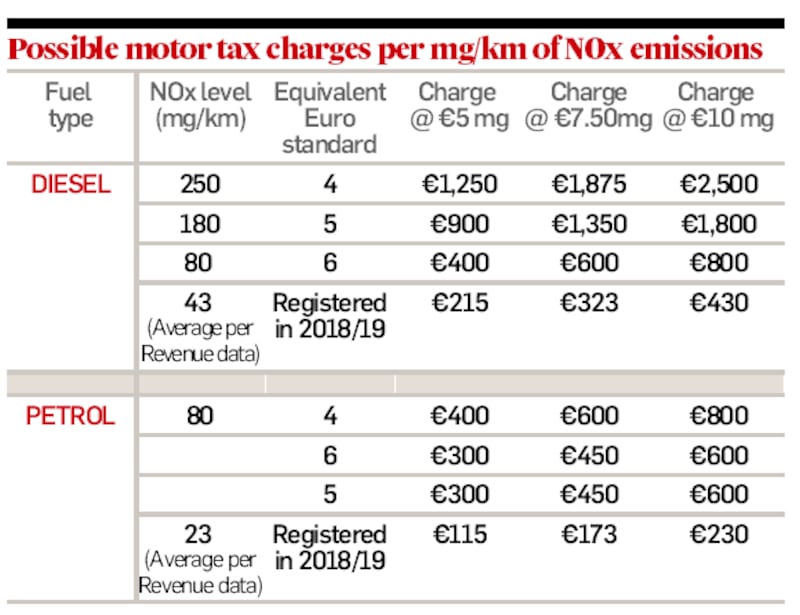Major changes to the motor tax regime are proposed in a new plan from senior Government officials. These involve an increase in the number of tax bands for Vehicle Registration Tax (VRT), changes to the grants and tax relief on hybrids and electric cars, and replacing the diesel surcharge.

A paper from the Department of Finance tax strategy group, drafted by senior officials laying out options for Minister for Finance Paschal Donohoe's next budget, also proposes delaying until July 2020 the use of new tougher CO2 emissions figures when applying tax on new cars and used imports.
The paper outlines moves to strengthen the environmental rationale of the VRT regime. It suggests a new formula that would include fixed and variable elements to remove the stepped nature of the current regime.
VRT changes
The proposed alternative tax regime would see the number of VRT bands increase from 11 to 14, with a new low rate of 7 per cent applied to vehicles with emissions below 51g/km. An additional band of 8 per cent VRT would apply for vehicles between 51g/km and 80g/km. A higher tax band applies for every 10g/km thereafter up to 201g/km and higher, where a new 39 per cent tax rate would apply.
A new EU-wide testing regime introduced this year – known as WLTP – will result in higher emissions ratings on all new cars. As both VRT and motor tax is rated on a car’s emissions, this will have implications for Irish motorists and exchequer returns.
The strategy group report says: “In recognition of the lead-in time for dealerships ordering vehicles, it does not seem unreasonable that the commencement should be delayed until July 2020.”
In applying VRT on used imports that only have ratings under the old testing regime, the group considers two options – increasing the old rating by 21 per cent and applying the tax on that figure, or using a sliding scale suggested by the EU.

The paper states that VRT is “a highly pro-cyclical tax, with car registrations linked to the economic climate”. It estimates this year’s VRT yield will be €942 million, based on 113,550 new car sales and 103,976 used car imports. That is up €57 million on last year.
The paper warns that the anti-diesel sentiment in the UK, due to a range of government measures introduced there, is feeding into the increase in diesel imports into the Republic.
"The trend of large volumes of used diesels being imported from the UK to Ireland must be considered in view of the specific contribution of diesels to environmental health."
Hybrids and electric cars
In terms of tax relief and grants for hybrids and electric cars, the paper says there is emerging evidence that the CO2 emission levels for conventional hybrids under the new WLTP emissions tests may be substantially higher than the values produced under the current test system.
“It is difficult to provide a continuing justification for the extension of VRT relief for conventional hybrids in view of the emerging evidence,” the report states. If the current relief was removed from hybrids, it says the conventional hybrids would gain from a lower VRT rate in any event under the proposed new bands.
It also proposes a limit to the €5,000 tax relief on fully-electric vehicles. The relief would apply only to cars up to €40,000, after which it would be reduced at a rate of 50 per cent per €1, with no relief available for cars over €50,000. However, electric cars would benefit from the new lower rate of 7 per cent VRT for vehicles with emissions below 50g/km.
Diesel surcharge
The paper suggests replacing the current 1 per cent surcharge on diesels for a charge linked to Nitrogen Oxide (NOx) and other air pollutants. It says a charge of €5 per mg/km NOx could apply. For the average new diesel car - with an NOx level of 43 mg/km, the charge would be €215, while for the average new petrol car with a level of 23 mg/km it would be €115. A similar system is in operation in Norway. This NOx levy would be charged on all new cars and used imports.
The strategy group says motor tax receipts for passenger cars have been falling in the last five years due to the lower emissions of newer cars. The average tax receipt per car has fallen from €466 in 2014 to an estimated €342 this year.
It proposes changes that would strengthen the environmental rationale while also seeking to reverse the structural decline in tax receipts, with increases for cars with emissions over 80g/km.
Benefit in Kind
In relation to the Benefit in Kind tax regime, the paper proposes reducing the number of mileage bands from five to four. The mileage on the highest tax band of 30 per cent would be increased to 26,000 kms, while the lowest rate would apply to vehicles with annual mileage over 52,001kms. There would also be discounted rate for lower emission vehicles, under 100 g/km, and a surcharge on vehicles above 139 g/km.
>Increasing carbon tax from €20 per tonne to €80 by 2030 will add 17.2 cent per litre of petrol and 19.65 cent per litre of diesel.















